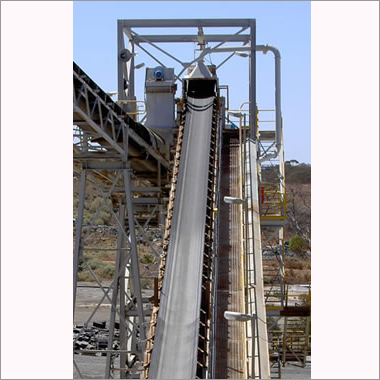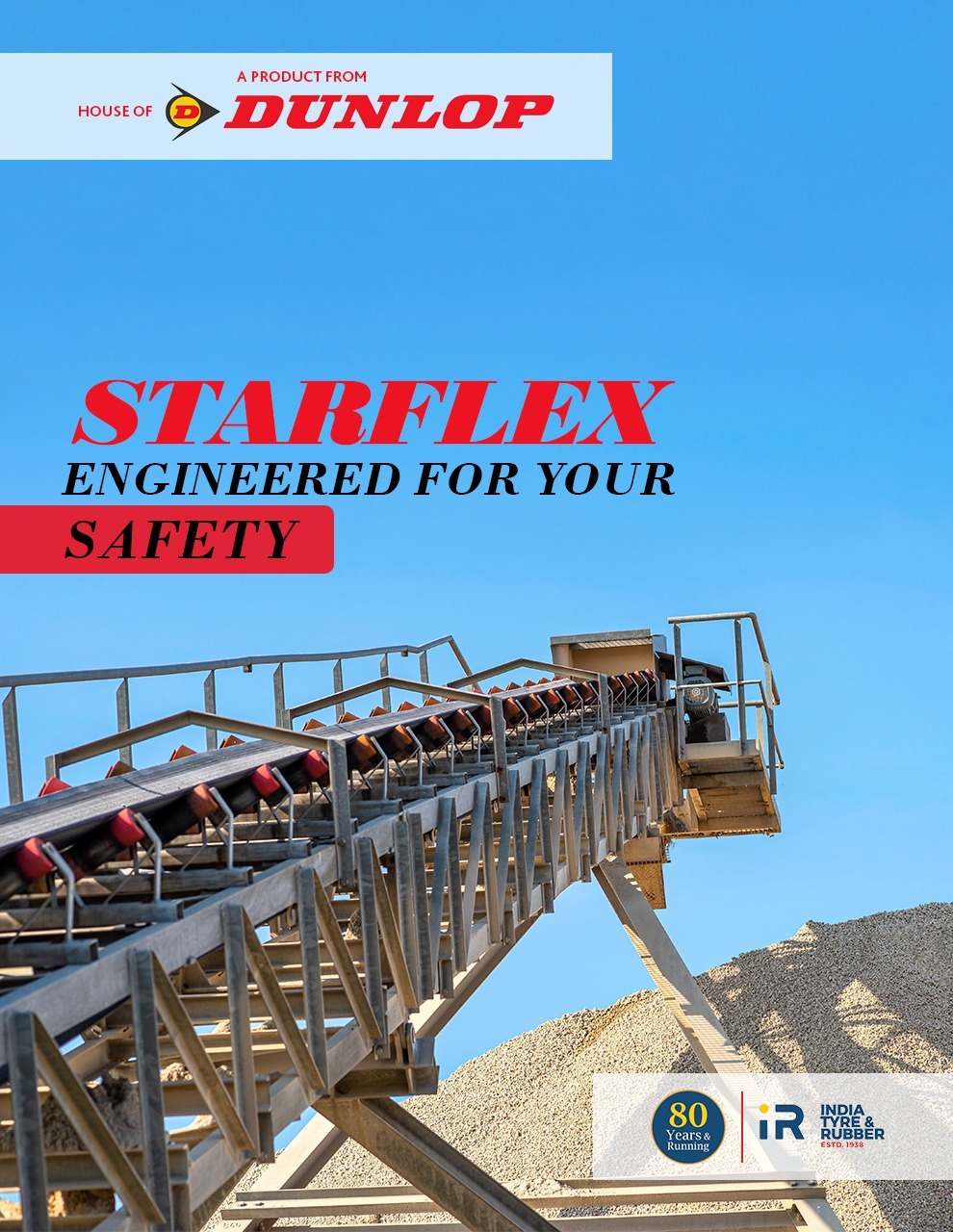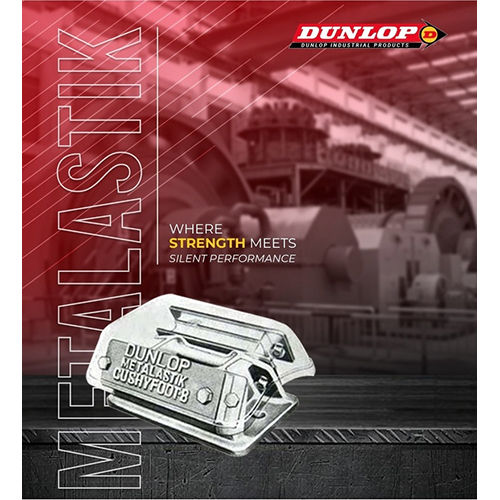Metal Conveyor Belts
Metal Conveyor Belts Specification
- Color
- Grey
- Size
- Standard
- Usage
- Construction
- Surface Finish
- Polished
- Material
- Mild Steel
- Voltage
- 220-440 Volt (v)
- Warranty
- 1 Year
- Usage & Applications
- Industrial
Metal Conveyor Belts Trade Information
- Minimum Order Quantity
- 100 Meters
- Supply Ability
- 100000 Meters Per Month
- Delivery Time
- 4 Week
- Main Domestic Market
- All India
About Metal Conveyor Belts
Metal Conveyor Belting:
Offered Metal Conveyor Belts are accessible in both polyester-nylon and nylon carcass. These belts can be composed by using grade M-24, grade N-17, grade HR, grade SHR and grade FR rubber material. In addition, offered belts are composed with uniquely mixed synthetic compounds that deliver ideal resistance to animal and vegetable oils alongside mineral. Moreover, our Conveyor Belts are intended to notify the least ensured complete thickness tensile power and various synthetic textile reinforcing piles. A nylon or polyester fabric is deployed in our belts that offer mechanically a high impact abuse and a low strength resistance.
Key Features:
- Highly oppose effect add accidental damage
- The integrated fabric has the least elongation
- Have superior adhesion construction
- Safe to fatigue against belt flexing
Dunlop Starfelx conveyor belting is available in both-all Nylon (NN) and Polyester-Nylon (EP) carcass and can be manufactured with the following cover rubber grades.
Grade M-24: Compounded from premium quality natural rubber to provide excellent resistance to cutting, gouging, tear and wear, and conforms to the maximum abrasion loss value specified for grade M in DIN 22102 of 1970 & IS: 1891 (Part-I) latest.
Grade N-17: Compounded rubber with improved flex life for moderately abrasive material conforming to the maximum abrasion loss value specified from Grade N in DIN 22102 of 1970 & IS: 1891 (Part-I) latest.
Grade HR: Specially compounded rubber capable of withstanding thermal degradation for prolonged periods and recommended for handling materials like alumina, ash, clinker, foundry sand etc. at temperatures above 65oC and up to 120oC for fines and 140oC for coarse materials, & IS: 1891 (Part-I) latest.
Grade SHR: Thoroughly proven in the field this grade has been specially formulated, using selected synthetic and natural rubber, to provide superior heat and abrasion resistance and is recommended for handling material like foundry sand, clinker, coke wharf, coke breeze and sinter having temperature over 65oC and up to 180oC for coarse and 160oC for fines.
Grade FR: The growing demand for fire resistant rubber conveyor belting was first catered to by Dunlop with grade of cover rubber. Our technologists have developed FR belting to meet any of the two following standards.
The Canadian Bureau of Mines(CBM)
Specification- Certification service for underground mining and equipment and materials, EMR, Canada- ERP/MRL-80-21 (TR) of september 1980 and
The canadian standards association specification (CSA) no. CAN/CSA-M422-M87 of 1987-Type C
Dunlop is among the few manufacturers worldwide to have received certification (No. 836) from the canadian centre for mineral and energy technology for conformation to type C of the CSA specifications including Drum Friction, Anstisatic and Flame Test requirements.
Grade OR: This cover grade with specially blended synthetic compounds is designed to give the best possible resistance to mineral, vegetable and animal oils.
Standards Applicable
Dunlop all-syntghetic starflex conveyor belting conforms the following standards, as and wherever applicable: IS: 1891 (Parts I, II and III )
- BS: 490 (part I)
- DIN 22102
- ERP/MRL-80-21 (TR)
- CAN/CSA-M422-M87
- IPSS: 2-03-006-88
Technical Data
Dunlop Starflex conveyor Belts are designated to denote the minimum guaranteed full thickness tensile strength and the number of reinforcing piles of synthetic textiles e.g. 500/3 denotes a belt having a minimum guaranteed full thickness tensile strength of 500kN/m. Incorporating 3 plies of textile reinforcement.
SPECIALITY OF FABRIC USED IN CONVEYOR BELT
Polyester /Nylon Fabric (EP) Conveyor Belt
The construction of fabric used in this belt is polyester in wrap an nylon in Weft , which provides technically a low stretch and high impact abuse resistance .
Special Feature :
Resistance to compact : Polyester Belt greatly resist impact add accidental damage [up to ] over the impact resistance of cotton & viscous rayon belts depending upon the number of pipes .
Low Elongation : The belt with polyester Fabric has lower elongation than the belt using nylon fabric .
Resilliency for Supporting Loads: The polyester fabric beam construction and superior adhesion combine to ensure maximum resistance to fatigue from flexing of the belt carrying full loads and deep trough idlers.
Complete Moisture & Mildew Protection: The fabric permits higher adhesion of carcass. More Resistance to moisture and mildew protection than other fabric.
Nylon / Nylon Fabric (NN) Conveyor Belt
The Nylon / Nylon Conveyor belting offers maximum impact and damage resistance from carrying material .It is reasonably flexible and when used and when used as a carcass material for belt , quite suitable for transportng a variety of material such as Ore , Crushed Stones , Grains, Sand etc...
Special Features:
Exceptional shock & impact resistance : Nylon/ Nylon Fabric belt greatly resist impact and accidential da, mage depending upon the number of piles used in the belts .
Excellent Troughability & Flexibility : The polyester fabric beam construction and superior adhesion combine to ensure maximum resistance to fatigue from flexing of the belt carrying full loads and deep trough idlers.
Greater Resistance to water and Mildew : The fabric permits higher adhesion of carcass. More Resistance to moisture and mildew protection than other fabric.
Beside these , Nylon Fabric provides superior Fastner Holding ability and it's light weight enables usage of less motor power
Recommended Minimum Pulley Diameters
|
|
|
|
|
|
|
Carcass Thickness |
Recommended minimum Diameter in mm for Percentage of RMBT* Used |
|||||||||||
|
Polyamide Polyamide |
Polyester - Polyamide |
Over 60 upto 100 percent Type of Pulley |
Over 30 upto 60 percent Type of Pulley |
Upto 30 percent Type of Pulley |
||||||||
|
From |
To |
From |
To |
A |
B |
C |
A |
B |
C |
A |
B |
C |
|
- |
1.1 |
- |
0.9 |
100 |
- |
- |
- |
- |
- |
- |
- |
- |
|
1.2 |
1.3 |
1.0 |
1.1 |
125 |
100 |
- |
100 |
- |
- |
- |
- |
- |
|
1.4 |
1.7 |
1.2 |
1.4 |
160 |
125 |
100 |
125 |
100 |
- |
100 |
100 |
- |
|
1.8 |
2.2 |
1.5 |
1.8 |
200 |
160 |
125 |
160 |
125 |
100 |
125 |
125 |
100 |
|
2.3 |
2.7 |
1.9 |
2.3 |
250 |
200 |
160 |
200 |
160 |
125 |
150 |
160 |
125 |
|
2.8 |
3.5 |
2.4 |
2.9 |
315 |
250 |
200 |
250 |
200 |
160 |
200 |
200 |
160 |
|
3.6 |
4.4 |
3.0 |
3.7 |
400 |
315 |
250 |
315 |
250 |
200 |
250 |
250 |
200 |
|
4.5 |
5.5 |
3.8 |
4.6 |
500 |
400 |
315 |
400 |
315 |
250 |
315 |
315 |
250 |
|
5.6 |
7.0 |
4.7 |
5.8 |
630 |
500 |
400 |
500 |
400 |
315 |
400 |
400 |
315 |
|
7.1 |
8.8 |
5.9 |
7.4 |
800 |
630 |
500 |
630 |
500 |
400 |
500 |
500 |
400 |
|
8.9 |
11.1 |
7.5 |
9.2 |
1000 |
800 |
630 |
800 |
630 |
500 |
630 |
630 |
500 |
|
11.1 |
13.8 |
9.3 |
11.5 |
1250 |
1000 |
800 |
1000 |
800 |
630 |
800 |
800 |
630 |
|
13.9 |
15.5 |
11.6 |
12.9 |
1400 |
1250 |
1000 |
1250 |
1000 |
800 |
1000 |
1000 |
800 |
|
15.6 |
17.7 |
13.0 |
14.8 |
1600 |
1250 |
1000 |
1250 |
1000 |
800 |
1000 |
1000 |
800 |
|
17.8 |
20 |
14.9 |
16.6 |
1800 |
1400 |
1250 |
1400 |
1250 |
1000 |
1250 |
1250 |
1000 |
|
|
|
16.7 |
18.5 |
2000 |
1600 |
1250 |
1600 |
1250 |
1000 |
1250 |
1250 |
1000 |
CONVEYOR PROBLEM ==== Causes & remedy
|
|
PROBLEM |
REMEDY |
|
1 |
Idlers or pulleys cut-of square with the center line of belt |
Readjust idlers at the affected area |
|
2 |
Conveyor frame of structure crooked |
Straighten in affected area |
|
3 |
Idler stands not centered on belt |
Readjust idlers in affected area |
|
4 |
Sticking Idlers |
Free idlers and improve maintenance and lubrication |
|
5 |
Build up of material on idlers |
Remove accumulation, improve maintenance, install scrapers or other cleaning devices |
|
6 |
Belt not joined squarely |
Remove affected splice & re-splice |
|
7 |
Bowed belt |
For new belt this condition should disappear during break-in; in rare cases belt must be straightened or replaced; check storage & handling of belt rolls |
|
8 |
Off centre loading or poor loading |
djust chute to place load on center of belt discharge material in direction of belt travel at or near belt speed |
|
9 |
Slippage of belt pulley |
Increase tension through screw take-up add counter weight; lag drive pulley; increase arc of contact |
|
10 |
Material slippage and build-up |
Improve loading & transfer condition; install cleaning device; improve maintenance |
|
11 |
Bolt heads protruding above lagging |
Tighten bolts; replace lagging; use vulcanized on lagging |
|
12 |
Tension too high |
Increase speed; same tonnage; reduce friction with better maintenance; replace damage idlers; decrease tension by increasing arc of contact or go to lagged pulley; reduced CWT to minimum amount |
|
13 |
Skirt board improperly adjusted or wrong material |
Adjust skirt board supports to minimum 25 mm between metal & belt with gap increasing in the direction of belt travel; use skirt board rubber (not old belt) |
|
14 |
Belt spanking down under load impact |
Install cushion idlers |
|
15 |
Material hanging up in or under chute |
Improve loading to reduce spillage; install buffer; widen chute |
|
16 |
Impact of material on belt |
Reduce impact by improving chute design; install impact idlers |
|
17 |
Material trapped between belt & pulley |
Install plows or scrapers on return run ahead of tail pulley |
|
18 |
Belt edges folding up on structures |
Same corrections as for 1, 2, 3; install limit switches; provide more clearance |
|
19 |
Dirty, stuck or misaligned return rolls |
Remove accumulations; install cleaning devices; use self-cleaning return rolls; improve maintenance & lubrication; cover quality too low; replace belt with heavier cover gauge or higher quality rubber |
|
20 |
Cover quality too low |
Replace belt with heavier cover gauge or higher quality rubber |
|
21 |
Spilled oil or grease |
Over-lubrication of idlers; improve house keeping; reduce quantity of grease used; check grease seals |
|
22 |
Wrong type of fasteners; Too tight or too loose |
Use proper fasteners & splice technique; set-up schedule for regular fastener inspection |
|
23 |
Heat or chemical damage |
Use belt designed for specific condition |
|
24 |
Fastener plates too long for pulley sizes |
Replace with smaller fastener; increase pulley size |
|
25 |
Improper transition between troughed belt & terminal pulleys |
Adjust transition |
|
26 |
Severe convex (hump) vertical curve |
Decrease idler spacing in curve; increase curve radius |
|
27 |
Excessive forward tilt of trough rolls |
Reduce forward tilt of idlers to no more than 2 from vertical |
|
28 |
Excess gap between idler rolls |
Replace with heavier rolls |
|
29 |
Insufficient transverse stiffness |
Replace with proper belt |
|
30 |
Pulleys too small |
Use larger diameter pulleys |
|
31 |
Counter weight too light |
Add counter weight or increase screw take-up to value determined from calculation |
|
32 |
Counter weight too heavy |
Lighten counter weight to value required by calculation |
|
33 |
Pulleys lagging worn |
Replace pulley lagging |
|
34 |
Insufficient traction between pulley & belt |
Lag drive pulley; Increase belt warp; Install belt cleaning device |
|
35 |
System underrated |
Recalculate belt tension & select proper belt |
|
36 |
Excessive sag between idlers causing load to work & shuffle on belt as it passes over idlers |
Reduce idler spacing |
|
37 |
Improper storing or handling |
Follow correct storing & handling procedure |
|
38 |
Belt improperly spliced |
Re-splice using proper method |
|
39 |
Belt running off-centre around the tail pulley & through the loading area |
Install training idlers on the return run prior to tail pulley |
|
40 |
Belt hitting structure |
Install training idlers on carrying 7 return run |
|
41 |
Improper belt installation causing apparent excessive belt stretch |
Pull belt through counter weight with a tension equal to at least empty running tension; run belt in with mechanical fasteners |
|
42 |
Improper initial positioning of counterweight in its carriage cause apparent excessive belt stretch |
Reposition & correct counter weight |
|
43 |
Insufficient counterweight travel |
Check counterweight & correct it |
|
44 |
Structure not level |
Level structure in affected area |
|
45 |
Covers cut on very small cover punctures allow fines to work under cover & cut covers away from carcass |
Make spot repair with vulcanizer or self-curing repair |





Price:
- 50
- 100
- 200
- 250
- 500
- 1000+
More Products in Industrial Conveyor Belts Category
Heavy Duty Conveyor Belt
Price 1500 INR / Meter
Minimum Order Quantity : 100 Meters
Color : Black
Product Type : Heavy Duty Conveyor Belt
Rubber Conveyor Belt
Price 1500 INR / Meter
Minimum Order Quantity : 100 Meters
Color : Silver
Product Type : Rubber Conveyor Belt
Warranty : 1 Year
Surface Finish : Polished
Heavy Heavy Duty Conveyor Belts
Price 1000 INR / Meter
Minimum Order Quantity : 100 Meters
Color : Black
Product Type : Heavy Heavy Duty Conveyor Belts
Warranty : 1 Year
Surface Finish : Polished
STARFLEX Coveyor Belt
Minimum Order Quantity : 100 Meters
Color : Silver
Product Type : STARFLEX Coveyor Belt
Warranty : 1 Year
Surface Finish : Painted
 |
DUNLOP INDUSTRIAL PRODUCTS PRIVATE LIMITED
All Rights Reserved.(Terms of Use) Developed and Managed by Infocom Network Private Limited. |







 Send Inquiry
Send Inquiry






